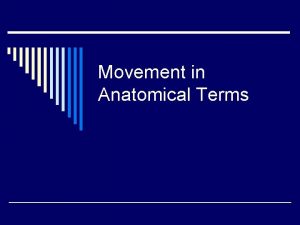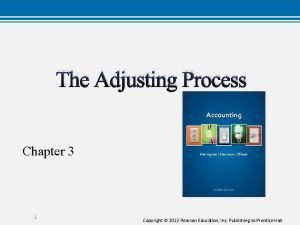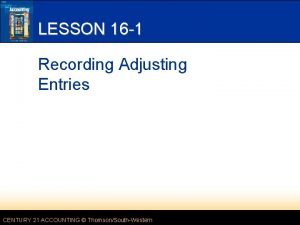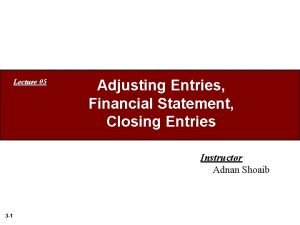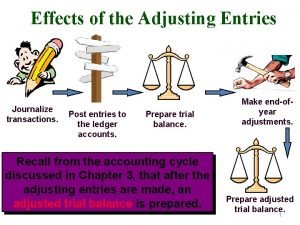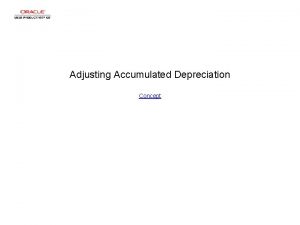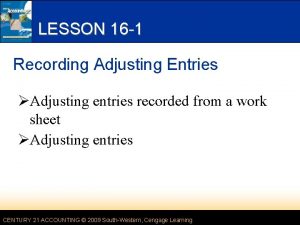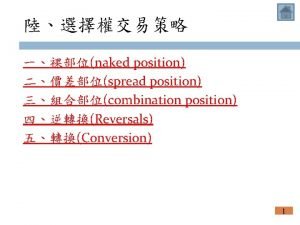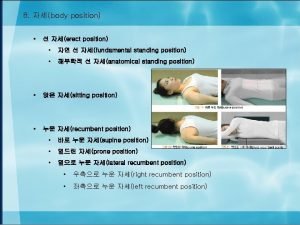Slide for adjusting the presenter position Start of






















































































- Slides: 86

Slide for adjusting the presenter position

Start of new take Cut after this slide

Maximum likelihood estimation with numerical optimization

Why should an applied researcher care?

Likelihood function Value Likelihood Cumulative likelihood Log likelihood 2 0. 2420000 -1. 419 -1. 42 3 0. 399 0. 0965000 -0. 919 -2. 34 4 0. 242 0. 0234000 -1. 419 -3. 76 Concave function Mean estimated, variance fixed at one Cumulative log likelihood

Finding the maximum bisection method 0 2. 5 2. 97 3. 12 3. 75 2. 81 5

Newton’s method (Newton-Rhapson) Yihui Xie (2013). animation: An R Package for Creating Animations and Demonstrating Statistical Methods. Journal of Statistical Software, 53(1), 1 -27. URL http: //www. jstatsoft. org/v 53/i 01/.

Newton’s method (Newton-Rhapson) Yihui Xie (2013). animation: An R Package for Creating Animations and Demonstrating Statistical Methods. Journal of Statistical Software, 53(1), 1 -27. URL http: //www. jstatsoft. org/v 53/i 01/.

Newton’s method (Newton-Rhapson) Yihui Xie (2013). animation: An R Package for Creating Animations and Demonstrating Statistical Methods. Journal of Statistical Software, 53(1), 1 -27. URL http: //www. jstatsoft. org/v 53/i 01/.

Newton’s method (Newton-Rhapson) When maximizing: With multiple parameters: First derivative Gradient vector Second derivative Hessian matrix Convergence Yihui Xie (2013). animation: An R Package for Creating Animations and Demonstrating Statistical Methods. Journal of Statistical Software, 53(1), 1 -27. URL http: //www. jstatsoft. org/v 53/i 01/.

Newton’s method can fail Yihui Xie (2013). animation: An R Package for Creating Animations and Demonstrating Statistical Methods. Journal of Statistical Software, 53(1), 1 -27. URL http: //www. jstatsoft. org/v 53/i 01/.

Newton’s method can fail Yihui Xie (2013). animation: An R Package for Creating Animations and Demonstrating Statistical Methods. Journal of Statistical Software, 53(1), 1 -27. URL http: //www. jstatsoft. org/v 53/i 01/.

Newton’s method can fail Yihui Xie (2013). animation: An R Package for Creating Animations and Demonstrating Statistical Methods. Journal of Statistical Software, 53(1), 1 -27. URL http: //www. jstatsoft. org/v 53/i 01/.

Newton’s method can fail Yihui Xie (2013). animation: An R Package for Creating Animations and Demonstrating Statistical Methods. Journal of Statistical Software, 53(1), 1 -27. URL http: //www. jstatsoft. org/v 53/i 01/.

Likelihood function What if we estimate both mean and SD? Value Likelihood Cumulative likelihood Log likelihood Cumulative log likelihood 2 0. 2420000 -1. 419 -1. 42 3 0. 399 0. 0965000 -0. 919 -2. 34 4 0. 242 0. 0234000 -1. 419 -3. 76

Numerical optimization of two-variable case

Numerical optimization of two-variable case 136 iterations Newton-Rhapson

Numerical optimization of two-variable case 11 iterations BFGS algorithm with numerical derivatives

Numerical optimization of two-variable case 138 iterations BFGS algorithm with numerical derivatives

Gradient and hessian mean Gradient vector Hessian matrix

Gradient and hessian mean Gradient vector Hessian matrix

Gradient and hessian mean Gradient vector Hessian matrix

Gradient and hessian Gradient vector Hessian matrix

Reasons for convergence problems and possible solutions Problem Solutions Optimization algorithm fails Different algorithm Better starting values Likelihood or derivatives cannot be calculated Different algorithm Better starting values Computer implementation fails Different algorithm Better starting values Different software Not enough iterations Different algorithm Better starting values More iterations Maximum does not exist Modify model Collect more data Solution is not unique (model not identified) Modify model Solution is not unique (empirical underidentification) Modify model Collect more data

End of a good take Cut before this slide

Start of new take Cut after this slide

Hessian matrix in maximum likelihood estimation

Why should an applied researcher care?

Finding the maximum of likelihood

Newton’s method (Newton-Rhapson) When maximizing: With multiple parameters: First derivative Gradient vector Second derivative Hessian matrix Convergence Yihui Xie (2013). animation: An R Package for Creating Animations and Demonstrating Statistical Methods. Journal of Statistical Software, 53(1), 1 -27. URL http: //www. jstatsoft. org/v 53/i 01/.

Convex and concave functions Convex Strictly convex Concave Strictly concave ≥ 0 >0 ≤ 0 <0 Maximum, concave Not concave Neither convex nor concave

Gradient and hessian Gradient vector Hessian matrix

Newton’s method in matrix form •

Newton’s method in matrix form • Distance Direction and distance

Newton’s method in matrix form • If f is steep with respect to m, adjust m more If f curves heavily with respect to s, adjust m more Both equal 0 at convergence Direction for mean Direction for sd Distance Direction and distance If slope of f with respect to m decreases with s, adjust m less If f is steep with respect to s, adjust m less

Convex and concave functions Convex Strictly convex Concave Strictly concave ≥ 0 >0 ≤ 0 <0 ≥ 0 >0 Positive semidefinite Positive definite Negative semidefinite Negative definite ≥ 0 >0 ≤ 0 <0

Convex and concave functions Convex Strictly convex Concave Strictly concave ≥ 0 >0 ≤ 0 <0 ≥ 0 >0 Positive semidefinite Positive definite Negative semidefinite Negative definite ≥ 0 >0 ≤ 0 <0

Negative definite: Diagonal elements are negative and off-diagonal zero

Negative definite: Diagonal elements are negative and off-diagonal zero

Not negative definite: Some diagonal elements non-negative and off-diagonal zero s is not identified

Not negative definite: Some diagonal elements non-negative and off-diagonal zero Saddle point

Convex and concave functions Diagonal elements should be negative Convex Strictly convex Concave Strictly concave ≥ 0 >0 ≤ 0 <0 ≥ 0 >0 Positive semidefinite Positive definite Negative semidefinite Negative definite ≥ 0 >0 ≤ 0 <0 Possible identification problem

Negative definite: Diagonal elements are negative and off-diagonal non-zero

Negative definite: Diagonal elements are negative and off-diagonal non-zero Sign of the off-diagonal elements is not important

Not negative definite: Diagonal elements are negative and off-diagonal non-zero s and m are not identified e. g. estimate: mean(x) = s + m, sd(x) = 1 Absolute value of the off-diagonal element large enough to make the function flat or curve up

Not negative definite: Diagonal elements are negative and off-diagonal non-zero

Not negative definite: Diagonal elements are negative and off-diagonal non-zero

Convex and concave functions Convex Strictly convex Concave Strictly concave ≥ 0 >0 ≤ 0 <0 ≥ 0 >0 Are the off-diagonal elements large enough to make the surface flat or bend it up? Positive semidefinite Positive definite Negative semidefinite Negative definite ≥ 0 >0 ≤ 0 <0 Possible identification problem

What should an applied researcher do? 1. Important to check the last iteration 2. Print out gradient and Hessian 3. Is gradient all zeros? 4. Are the diagonal elements of Hessian all negative 5. Are any of the offdiagonal elements large in absolute value compared to the diagonal elements Note: some statistical software minimize negative log likelihood

End of a good take Cut before this slide

Start of new take Cut after this slide

Matrix algebra

Why should an applied resercher care about matrices? • Reason 1: Understanding books about methods • Reason 2: Matrices are convenient or required for certain calculations • Calculating model implied correlations • Generating simulated dataset • Exporting results as matrices for reproducibility Wooldridge, J. M. (2002). Econometric analysis of cross section and panel data. The MIT Press, p. 189 -190

Diagonal Upper triangle Symmetric matrix Square matrix: m=n Lower tringle Notation: • a – scalar – lower case not bold • a – vector – lower case bolded • A – matrix – upper case bolded Wooldridge, J. M. (2013). Introductory econometrics: A modern approach (5 th ed). South-Western Cengage Learning.

Wooldridge, J. M. (2013). Introductory econometrics: A modern approach (5 th ed). South-Western Cengage Learning.

Useful matrix operations to know • Transpose • Addition • Multiplication • Inverse • Determinant

Wooldridge, J. M. (2013). Introductory econometrics: A modern approach (5 th ed). South-Western Cengage Learning.

Wooldridge, J. M. (2013). Introductory econometrics: A modern approach (5 th ed). South-Western Cengage Learning.


Wooldridge, J. M. (2013). Introductory econometrics: A modern approach (5 th ed). South-Western Cengage Learning.

Dimensions of new matrix Must be same 3× 2 3× 3 2× 3

Dimensions of new matrix Must be same 3× 2 3× 3 2× 3

3× 3 3× 2 2× 3

3× 3 3× 2 2× 3

3× 3 3× 2 2× 3

3× 3 3× 2 2× 3

3× 3 3× 2 2× 3

3× 3 3× 2 2× 3

3× 3 3× 2 2× 3

Model implied covariances x 1 x 2 y 1 u 1 y 2 u 2

Model implied covariances x 1 x 2 y 1 u 1 y 2 u 2

Model implied covariances x 1 x 2 y 1 u 1 y 2 u 2 x 1 x 2 y 1 y 2

Matrices: Scalars: Wooldridge, J. M. (2013). Introductory econometrics: A modern approach (5 th ed). South-Western Cengage Learning.

Linear regression in matrix form Wooldridge, J. M. (2013). Introductory econometrics: A modern approach (5 th ed). South-Western Cengage Learning.

What’s the meaning of these equations? Wooldridge, J. M. (2013). Introductory econometrics: A modern approach (5 th ed). South-Western Cengage Learning.

Cross-product matrix X’X n observations • k variables n observations k variables Assume that all variables are centered

Cross-product matrix X’X •

Cross-product matrix X’X • Zero

Cross-product matrix X’X • Scaled version of the covariance matrix

~Covariances between X and e Error term ~Model implied covariances Fitted values ~Observed covariances Wooldridge, J. M. (2013). Introductory econometrics: A modern approach (5 th ed). South-Western Cengage Learning.

This is the equation that the computer uses Wooldridge, J. M. (2013). Introductory econometrics: A modern approach (5 th ed). South-Western Cengage Learning.

Determinant Cannot divide by 0 Distance from 0 • 1. 5 -2 -1 0 1 Area = Determinant x y Linear dependency: One vector can be expressed as weighted sum of others Cannot invert matrix if determinant =0 2

Useful matrix operations to know • Transpose • Addition • Multiplication • Inverse • Determinant

End of a good take Cut before this slide

Start of new take Cut after this slide

End of a good take Cut before this slide
 Brunn karttecken
Brunn karttecken Heel and toe polka meaning
Heel and toe polka meaning Second position echappe
Second position echappe Presenter position
Presenter position If you gotta start somewhere why not here
If you gotta start somewhere why not here Jump start triage algorithm
Jump start triage algorithm Slide and divide method of factoring
Slide and divide method of factoring Fundamental position vs anatomical position
Fundamental position vs anatomical position How many fundamental starting position
How many fundamental starting position Fspos vägledning för kontinuitetshantering
Fspos vägledning för kontinuitetshantering Typiska drag för en novell
Typiska drag för en novell Tack för att ni lyssnade bild
Tack för att ni lyssnade bild Vad står k.r.å.k.a.n för
Vad står k.r.å.k.a.n för Varför kallas perioden 1918-1939 för mellankrigstiden?
Varför kallas perioden 1918-1939 för mellankrigstiden? En lathund för arbete med kontinuitetshantering
En lathund för arbete med kontinuitetshantering Särskild löneskatt för pensionskostnader
Särskild löneskatt för pensionskostnader Personlig tidbok fylla i
Personlig tidbok fylla i A gastrica
A gastrica Vad är densitet
Vad är densitet Datorkunskap för nybörjare
Datorkunskap för nybörjare Boverket ka
Boverket ka Hur skriver man en debattartikel
Hur skriver man en debattartikel För och nackdelar med firo
För och nackdelar med firo Nyckelkompetenser för livslångt lärande
Nyckelkompetenser för livslångt lärande Påbyggnader för flakfordon
Påbyggnader för flakfordon Lufttryck formel
Lufttryck formel Offentlig förvaltning
Offentlig förvaltning Kyssande vind analys
Kyssande vind analys Presentera för publik crossboss
Presentera för publik crossboss Teckenspråk minoritetsspråk argument
Teckenspråk minoritetsspråk argument Vem räknas som jude
Vem räknas som jude Treserva lathund
Treserva lathund Epiteltyper
Epiteltyper Claes martinsson
Claes martinsson Cks
Cks Byggprocessen steg för steg
Byggprocessen steg för steg Mat för unga idrottare
Mat för unga idrottare Verktyg för automatisering av utbetalningar
Verktyg för automatisering av utbetalningar Rutin för avvikelsehantering
Rutin för avvikelsehantering Smärtskolan kunskap för livet
Smärtskolan kunskap för livet Ministerstyre för och nackdelar
Ministerstyre för och nackdelar Tack för att ni har lyssnat
Tack för att ni har lyssnat Hur ser ett referat ut
Hur ser ett referat ut Redogör för vad psykologi är
Redogör för vad psykologi är Stål för stötfångarsystem
Stål för stötfångarsystem Atmosfr
Atmosfr Borra hål för knoppar
Borra hål för knoppar Vilken grundregel finns det för tronföljden i sverige?
Vilken grundregel finns det för tronföljden i sverige? Formel för standardavvikelse
Formel för standardavvikelse Tack för att ni har lyssnat
Tack för att ni har lyssnat Steg för steg rita
Steg för steg rita Ledningssystem för verksamhetsinformation
Ledningssystem för verksamhetsinformation Tobinskatten för och nackdelar
Tobinskatten för och nackdelar Toppslätskivling effekt
Toppslätskivling effekt Gibbs reflekterande cykel
Gibbs reflekterande cykel Egg för emanuel
Egg för emanuel Elektronik för barn
Elektronik för barn Fredsgudinna pax
Fredsgudinna pax Strategi för svensk viltförvaltning
Strategi för svensk viltförvaltning Kung dog 1611
Kung dog 1611 Humanitr
Humanitr Ro i rom pax
Ro i rom pax Tack för att ni lyssnade
Tack för att ni lyssnade Större och mindre tecken
Större och mindre tecken Lyrik
Lyrik Inköpsprocessen steg för steg
Inköpsprocessen steg för steg Fuktmätningar i betong enlig rbk
Fuktmätningar i betong enlig rbk Ledarskapsteorier
Ledarskapsteorier Kolposkopi, px
Kolposkopi, px Myndigheten för delaktighet
Myndigheten för delaktighet Trög för kemist
Trög för kemist Tillitsbaserad ledning
Tillitsbaserad ledning Läkarutlåtande för livränta
Läkarutlåtande för livränta Geometri för barn
Geometri för barn Vishnuiter
Vishnuiter Meios steg för steg
Meios steg för steg Bris för vuxna
Bris för vuxna Big brother rösta
Big brother rösta Chapter 18 adjustments and the ten-column worksheet answers
Chapter 18 adjustments and the ten-column worksheet answers Journalize adjusting entries
Journalize adjusting entries Limiting reactant example
Limiting reactant example Adjusting the accounts chapter 3
Adjusting the accounts chapter 3 Century 21 south western accounting answer key
Century 21 south western accounting answer key Reversing entries
Reversing entries Journalizing adjusting entries
Journalizing adjusting entries How to record accrued expense
How to record accrued expense Journalizing adjusting entries
Journalizing adjusting entries







